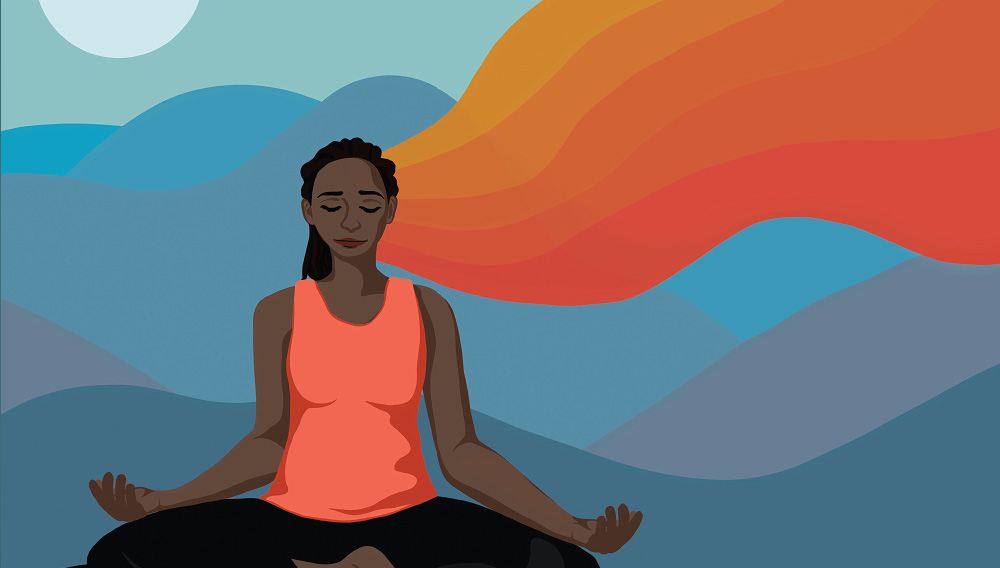Mind Over Matter

People have a lot on their minds these days — family, work, school, financial security, COVID-19. And although your mind may be full with all these competing thoughts, is it mindful?
Mindfulness is a practice that promotes intense concentration on the present rather than on becoming mired in daydreaming or competing thoughts. It’s a way to train our minds to notice what’s around us — to experience sights, sounds, sensations, and emotions in a nonjudgmental way. How many times have we driven to work, but when we arrive, we can’t recall the trip? That’s an example of mindless behavior, and that might come as no surprise, because our minds wander nearly half of the time. However, by being mindful of what’s around us, a new way of experiencing the world is ours to behold. Mindfulness doesn’t necessarily mean “overthinking;” it means “noticing new things,” according to Ellen Langer, professor of psychology at Harvard University and recognized as the “mother of mindfulness.”
V. Blue Lemay, faculty program director for the humanities at Excelsior College, explains how mindfulness can lead to better self-awareness. “I’d say that at least for me, it [mindfulness] is certainly being in the present moment, but it also allows me to be aware of myself in the present moment, much more than I would be if I were being distracted. Because of that self-awareness, I’m able to understand who I am at that moment,” Lemay states.
In addition, Lemay notes that mindfulness helps her examine her values with the end goal of becoming a better person.
Rather than analyzing things based on our past experiences, mindfulness promotes the here and now, allowing us to transcend ingrained thinking habits.
So where was the concept of mindfulness born? Its roots can be traced back to many religious, meditative traditions, but it is most often associated with Buddhism. Mindfulness as practiced today is credited to Jon Kabat-Zinn, who learned to meditate while working on his PhD in molecular biology at MIT. Initially, he applied the concepts of mindfulness to treat chronic pain and published his findings in 1982. Building on his initial success, he developed the eight-week Mindfulness-Based Stress Reduction (MBSR) program. He also established the Center for Mindfulness in Medicine, Health Care, and Society at the University of Massachusetts Medical School.
By applying renewed focus and awareness, coupled with living in the moment, mindfulness offers far-reaching positive effects ranging across many aspects of our lives. These include health benefits such as lowering blood pressure, managing pain, and improving sleep. In addition, mindfulness has been proven to promote better mental health by reducing stress and anxiety and helping to address addictive behaviors.
To learn that the value of mindfulness has permeated many aspects of our lives, including health care, the military, the workplace, as well as education, is no surprise. At Excelsior, for example, mindfulness is included among the General Education Career Competencies as a related skill under the Cultural Diversity and Expression competency.
Although focusing on self through the practice of mindfulness might sound like fertile ground for sowing the seeds of self-absorption and narcissism, nothing could be further from the truth. “It doesn’t mean putting blinders up — it means being focused; it’s not self-absorbed,” explains Ellen LaDieu, lead faculty program director for Excelsior’s School of Nursing.
Lemay adds further clarification, “I’m being self-aware because I care about my reactions with others. And so the more I can understand myself, the better my interactions with others will be. It’s about understanding you in that moment. If you choose to change your patterns so that you’re more aware of your values, it can have a profound effect on the world outside you.”
Mindfulness is a distinctly economical practice; it doesn’t require that you purchase specialized equipment or buy into a gym membership to exercise your brain in a beneficial manner. The primary investment is in devoting time to routine contemplation, either through meditation, deep breathing, or visualization to name a few techniques. “Mindfulness doesn’t tend to be very prescriptive at all,” observes Lemay. “You have to find out for yourself. It’s about creation. It’s about being curious.”
Lemay points out that the key to mindfulness is practice. In a contemporary world that is finely focused on achievement and acquisitions, learning to settle your mind and be quiet with yourself takes repetition. She notes, “You can have all the knowledge you want, read all the books you want about mindfulness, but, unless you really practice it, it’s just another cool trend, another entertaining gimmick that you can sort of be interested in but never fully explore or understand the benefits.”
Thirty minutes of meditation three times a day works best for Lemay. But mindfulness is not a one-size-fits-all tool. Molly Costello, program coordinator for Excelsior’s School of Undergraduate Studies, is a relative newcomer to mindfulness. “During particularly stressful times in my life, I practiced basic meditation for about 20 minutes twice a day,” she says. “However, I have found it more enjoyable and helpful by meditating for shorter periods of time. For beginners, even just taking a few minutes in the morning or at night to ground yourself and clear your mind of interruptions and unhelpful thoughts is very liberating.”
Of course, there are many resources, some free, some paid, that can guide you. For example, LaDieu uses a paid mobile application called Headspace. “It helps people to begin to learn meditation, mindfulness, and to be aware,” she explains. Other popular apps include Insight Timer; Stop, Breathe & Think (now known as MyLife); and Smiling Mind.
National museums offer online visualization opportunities to guide meditation and mindfulness. For example, the Rubin Museum of Art in New York City, which specializes in Himalayan art, culture, and ideas, has the Rubin Daily Offering five days a week. Here, practitioners, artists, teachers, and experts offer insights and tools using the collection’s artwork as inspiration.
Numerous books are available to guide the practice as well. Noted authority Kabat-Zinn has penned many of them, including “Mindfulness for Beginners: Reclaiming the Present Moment–And Your Life.” Both Lemay and Costello cite “The Mindful Leader” by Michael Bunting as an insightful addition to the knowledge base.
The practice of mindfulness has permeated all levels of education. Teaching this skill has been shown to reduce everyday stressors, benefitting both teachers and students. Mindfulness has been linked to improved academic achievement as well as to enhanced social and emotional learning. By concentrating on the present, students also may achieve better focus.
The Bethlehem Central Middle School in Delmar, New York, for example, has several mindfulness initiatives. “The middle school has been clued into rising mental health concerns for a number of years, and we’ve long espoused a foundational mission and charge of building students’ character as well as their academics,” explains middle school principal Mike Klugman. To that end, the school hosts a Monday Morning Mindful Minute via an announcement broadcast and sponsors a Mindful Morning club. The weekly club continued meeting via Google Meet when the COVID-19 pandemic shuttered schools. School guidance counselor Chynna Marcucci noticed many benefits among club members, including the students becoming more connected and thoughtful toward one another. She notes, “Kids are amazing and have an unexpected ability to practice mindfulness. They try so hard to access the position of calm mind and body.”
Mindfulness also complements the concept of the “presence of the nurse,” explains LaDieu. She was introduced to mindfulness through her interest in holistic nursing. “I need to be really present for the patient, so that’s really being mindful,” she explains, noting that it can be an important healing tool in health care. Studies have shown that nurses who engage in mindfulness develop better active listening and empathy skills. Being mindful can benefit not only the patient but also the practitioner. One study showed the nurses who participated in Kabat-Zinn’s MBSR program experienced reduced burnout and emotional exhaustion, for example.
This simple yet powerful tool has far-reaching benefits into other areas not typically associated with contemplative approaches. The military has tapped into mindfulness to help servicemembers gain focus and reduce distraction. In one case, mindfulness techniques were used to help infantry soldiers focus on when to pull the trigger to sharpen their shooting skills. Another study showed training that included mindful breathing helped participants better grasp important information during chaotic situations, an attribute that could benefit combat conditions. But it’s also used in more-supportive modalities, helping veterans cope with post-traumatic stress disorder (PTSD). Here mindfulness can be beneficial in helping the veteran focus on the present while not dwelling on the traumatic experience. The National Center for PTSD, part of the U.S. Department of Veterans Affairs, provides a free Mindfulness Coach mobile application that offers articles on mindfulness, an assessment, as well as practice aids.
Many companies have promoted mindfulness in the workplace primarily to increase productivity, but with the additional benefits of reducing employee stress and also sharpening focus. Among the major corporations that have sponsored mindfulness programs for employees are General Mills, Google, Bank of America, and Goldman Sachs to name a few. The positive outcomes can be impressive. For example, Duke University studied Aetna, a large managed health care company, where 10,000 employees took part in mindfulness or yoga classes. Participants reported improvement in their sleep quality and a reduction in pain levels. In addition and perhaps most important from a business standpoint, a weekly gain of an hour of productivity was also noted. Studies also show that mindfulness can promote better workplace relationships that can possibly support improved diversity and inclusion behaviors. Other research has shown that mindfulness leads to more ethical behavior, improved safety, and reduced employee turnover.
Not only is there a plethora of anecdotal reports on the benefits of mindfulness, but also there is supporting physiological evidence. For example, in one study, MRI results of participants in an MBSR course displayed increased grey-matter density in the area of the brain associated with learning and memory and decreased density in the areas attributed to anxiety and stress. Lemay cites the body’s fight-or-flight response in supporting mindfulness’s effect on the body. The amygdala in the brain is responsible for anger and fear and other emotional responses, but those who practice mindfulness have shown decreased activity in those areas. She explains, “Studies show that people who do mindfulness meditation have a lot more resiliency.” Other scientific explorations have uncovered that the practice of mindfulness has a positive effect on the treatment and prevention of heart disease.
No doubt mindfulness can be a useful practice throughout our lives, but perhaps even more so during highly stressful times such as the COVID-19 pandemic. Just as many parts of daily life were put on pause to slow the spread of the virus, so too can mindfulness decelerate stressful times while enhancing our overall well-being. Costello states, “One of the tactics that has proven most beneficial to me is simply taking a pause. When life gets hectic, it’s important to slow down and regroup.”
Albert Einstein said, “We can’t solve problems by using the same kind of thinking we used when we created them.” Mindfulness is a great example that shows the validity of his observation. It teaches us to pay attention to the present while embracing the full experience of life without being ensnared in old patterns and becoming distracted and lost. Rather than analyzing things based on our past experiences, mindfulness promotes the here and now, allowing us to transcend ingrained thinking habits. “Mindfulness gives me more opportunity to not get tied up and go off on some tangent,” says LaDieu. “It lets me look at the circumstances and information, and consider what’s going on in a mindful manner, allowing me to weather the punches easier.”


